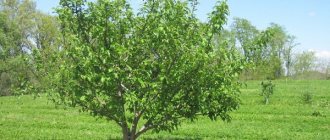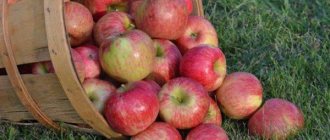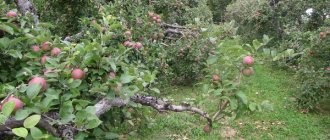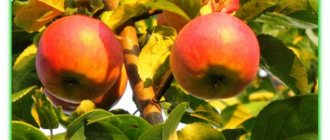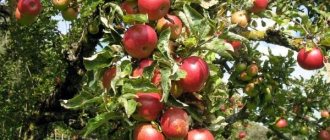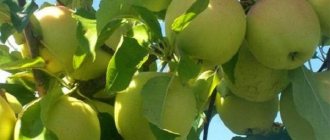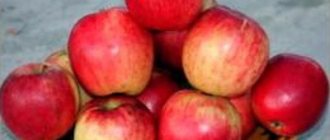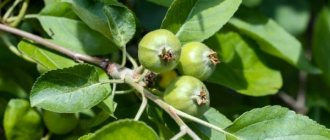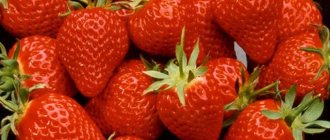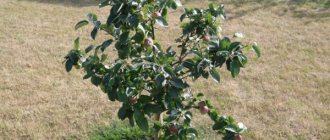The apple tree is the most widespread fruit crop in Russia. Thanks to breeders, many varieties have been developed for certain regions with different climatic conditions.
However, at the moment, a small number of summer varieties of apple trees with high resistance to fungal diseases for the Central regions of Russia.
That is why the famous breeder Petrov A.V. set himself the task of developing a new variety for this region, and thus the Brusnichnoe variety appeared. In order to find out all the additional benefits of the variety, you need to familiarize yourself with it in more detail. See further in the article for a photo and description of this variety.
Description, photo
Lingonberry is a late summer apple variety. The fruit crop was bred by A.V. Petrov in Moscow at the All-Russian Selection and Technological Institute for Horticulture and Nursery Growing from free pollination of the apple tree Slava Pobeditelem and an unknown variety.
Initially, the author developed an apple tree variety for the Central regions of Russia, but thanks to the taste of the fruit and fairly high frost resistance, the variety was appreciated in the Vladimir, Ivanovo, Tver regions, as well as in the Volga-Vyatka region.
Video Review
The apple tree is the most widespread fruit crop in Russia. Thanks to breeders, many varieties have been developed for certain regions with different climatic conditions.
However, at the moment, a small number of summer varieties of apple trees with high resistance to fungal diseases for the Central regions of Russia.
That is why the famous breeder Petrov A.V. set himself the task of developing a new variety for this region, and thus the Brusnichnoe variety appeared. In order to find out all the additional benefits of the variety, you need to familiarize yourself with it in more detail. See further in the article for a photo and description of this variety.
additional characteristics
Additional characteristics of the variety will allow you to get acquainted with its advantages and disadvantages, find out the frost resistance of the apple tree and its yield.
Advantages and disadvantages
The tree has many advantages over other varieties. The main advantages of the variety include:
- Precociousness;
- High yield;
- Annual fruiting;
- Frost resistance;
- Ease of care.
High yield is one of the advantages of the Lingonberry apple tree.
Weak resistance to scab and a short shelf life of fruits are considered disadvantages of this variety.
Dimensions of an adult tree
Refers to natural dwarfs. The tree is 2-3 meters tall , has a spreading, weeping crown, with thin branches.
Annual growth
The tree is weak growing . The annual growth of branches is no more than 7 cm.
The Lingonberry apple tree is low-growing.
Periodicity in fruiting
The apple tree is characterized by regular fruiting without periodicity.
You should know! In unfavorable years, the yield of a fruit crop may decrease.
Productivity
Due to early fruiting and high yield, gardeners harvest about 150 kg of fruit from an 8-year-old apple tree.
Tasting assessment
Small fruits, only 70 - 100 grams , have an elegant cherry-red color. The pulp is creamy, coarse-grainy in structure, juicy, sweet and sour taste.
The fruit of the Lingonberry apple tree.
Winter hardiness
The Brusnichnoe variety is a highly winter-hardy crop. The tree tolerates spring and autumn frosts quite well, as well as low temperatures in winter up to -40 degrees.
Disease resistance
In the summer season, with plenty of rainfall, the apple tree is extremely rarely susceptible to scab . Without proper care, fruit rot and cytosporosis may appear.
Lingonberry can be susceptible to fruit rot (moniliosis).
Watch the video for expert advice on how to deal with fruit rot:
Advantages and disadvantages of the variety
- The main advantages of the variety are:
- short stature and compactness of the tree;
- rapid onset of fruiting (especially in seedlings grafted onto clonal rootstocks) and its regularity;
- very high yields (up to 150 kg per tree that has reached 8 years of age);
- high winter hardiness;
- resistance to scab and most other fungal infections;
- beautiful appearance of the fruit;
- excellent taste characteristics.
Early fruiting, stable fruiting and high productivity allow us to classify the Brusnichnoe apple tree as an intensive type variety.
- Among the disadvantages of the variety are:
- small fruit;
- tendency of fruits to shed;
- average resistance to cytosporosis and fruit rot;
- high requirements for soil composition, light, humidity (cannot tolerate both drought and stagnation of water in the soil);
- dependence on pollinators (low ability to be pollinated by own pollen);
- short shelf life of the crop;
- the short life of the tree itself.
Reviews
Askerov. Sh. Maikop. "Good day. I would like to share with you my opinion about the Lingonberry apple tree. This variety appeared on our summer cottage quite a long time ago, about 15 years ago. During all this time, the fruit crop has characterized itself from the best side. An adult tree is small in size, which makes it easy to care for. Frosting of the upper branches occurs extremely rarely. There was no periodicity or decline in high yields. The fruits have a pleasant sweet and sour taste, which allows them not only to be used for processing, but also to be consumed fresh for about 1.5 months.”
Pelsh. N. Nizhny - Novgorod. “On the advice of my long-time friend, 8 years ago I purchased a Brusnichnoe seedling. In the end, I was very pleased with the variety. In a fairly short time, we received a high harvest of the most delicious, juicy fruits. The abundance of small apples allows you to prepare many different preserves, preserves, jams and marmalades.”
Elena. Moscow region. “The Cowberry apple tree is the best variety for the Moscow region! The tree does not take up much free time to care for, does not freeze, and is not subject to scab and other diseases. And the fairly high yield of the most delicious fruits will please every gardener.”
Features of planting and care
For good survival of the seedling and its proper development, it is necessary to follow the planting technique and further care.
Landing
Before planting a seedling, it is necessary to select the right site.
The fruit crop prefers good lighting and loamy, floodplain, sandy loam soils.
Deadlines
The best time for planting, according to most gardeners, is spring.
Watch the video on how to plant apple trees in spring:
Technology
- The hole for planting a seedling is prepared 3 weeks in advance.
- Humus, wood ash, superphosphate and potassium sulfate are added to a dug hole 1 m x 1 m, mixed with soil and left for the fertilizers to rot.
- After the specified time, a mound is formed in the hole, a seedling is installed, the rhizomes are straightened and covered with soil.
- After planting, the apple tree is watered abundantly and the soil is mulched.
Planting an apple tree.
Important! When planting, you cannot deepen the root collar of the tree; it should be 5 cm above ground level.
Distance
The planting pattern for the fruit crop is 2.5 meters between apple trees in a row and 4 meters between rows.
Apple tree rootstock
The best rootstock for the Brusnichnoe variety is considered to be M9 . A fruit crop grafted onto this rootstock not only begins to bear fruit early , but also has a fairly long lifespan.
Apple tree growth depending on the rootstock.
Growing
In order for the apple tree to take root well, gardeners advise performing a few small tricks, which will also contribute to high yields and long fruiting.
Experts recommend performing the following work:
- For good survival of the seedling, in the first year of planting, the entire blossom of the apple tree is plucked off;
- To increase the weight of fruits and higher frost resistance, crop rationing is carried out ;
- To prevent a decline in yield, do not allow the soil near the tree trunk to dry out . To do this, water the apple tree at least 3 times a month;
- Timely inspection of the tree will help identify the disease in the initial stages.
Advice! Controlling insect pests will also promote better fruit set.
Watch the video on how to identify apple tree diseases:
Agricultural technology
The nutrients added during planting will last the apple tree for a whole year. In subsequent years, the fruit crop is fed with nitrogen fertilizers in the spring . In the summer and autumn seasons, phosphorus and potassium preparations and complex fertilizers are applied.
In the summer-autumn period, apply complex fertilizers.
Pruning and crown formation
Proper pruning of the crown will help prevent the occurrence of various diseases. Gardeners carry out pruning in the following way:
- After planting, the branches of the seedling are immediately cut off by 1/3;
- The next year after planting, strong skeletal branches are left, all other shoots are cut back to the trunk itself;
- Further, in order to avoid thickening of the crown, all crooked and weak branches are removed every year in the spring.
Apple tree pruning diagram.
Advice! To avoid weakening the tree, do not trim a large number of branches at one time.
Watch the video on how to properly prune an apple tree:
Pollinator varieties
For 100% fruit set, the apple tree requires cross-pollination . The best varieties in this role are:
- Melba;
- Suislepskoe.
Melba.
Suislepskoe.
Diseases and pests
Lingonberry has good immunity to a number of ailments, but in cloudy and damp weather there is a risk of damage to trees:
- scab, which can be protected from by treating trees in early spring with a 1% solution of Bordeaux mixture (per 10 liters of water - 100 g of copper sulfate and 150 g of lime), as well as with Agat-25K;
- moniliosis. As a preventive measure against the disease, apple trees are sprayed with a 3% solution of Bordeaux mixture (300 g of copper sulfate and 450 g of lime per 10 liters of water) or Horus fungicide before budding;
- cytosporosis. The affected areas of the bark are carefully cut off with a sharp knife, treated with a solution of copper sulfate (30 g of the drug per 1 liter of water) and covered with garden pitch. To prevent the disease, trees must be treated with a solution of copper sulfate or the drug Hom.
Moniliosis on an apple tree.
Features of ripening and fruiting
The apple tree has its own characteristics in bearing tasty fruits.
Fruiting
Start
This apple tree is a fast-growing crop. Gardeners collect the first harvest 2–3 years after planting.
Lingonberry begins to bear fruit in 2-3 years.
Peculiarities
Fruiting of the variety is quite extended . To avoid shedding of apples, which is so typical of the plant, the fruits are eaten in stages.
Deadlines
Blooms
The flowering period of the tree falls on the 2nd - 3rd decade of May.
Fruit ripening
The apple tree is characterized by non-simultaneous ripening of fruits. The first ripe fruits appear on the tree at the end of September.
Lingonberry ripens by the end of September.
Storage
The short shelf life allows the fruit to be consumed fresh for no more than 1 month . Gardeners recommend immediately processing the fruits in various preserves after picking.
Apple tree Cowberry
Every year, amateur gardeners try to further improve the Cowberry apple tree; thanks to their work, new forms of growing the variety appear.
On a dwarf rootstock
The Lingonberry apple tree on a dwarf rootstock has a height of no more than 2 meters and a shallow root system. In order for the fruit crop to develop well, gardeners recommend planting the seedling in fertile soil and forming the crown in layers.
Lingonberry on a dwarf rootstock.
This form is used in the following cases:
- Saving space on the site;
- For mountain slopes;
- To create trellises.
Attention! Apple trees on this rootstock are valued for their high productivity and resistance to scab.
Columnar
The columnar apple tree has a column-shaped trunk and sparse vertical skeletal branches. Due to the fact that the trunk is overgrown with short fruit shoots, the fruits are located both on the branches and on the trunk itself.
The advantages of this subspecies include the following indicators:
- In a small area you can plant a larger number of fruit crops;
- Precociousness. The apple tree begins to bear fruit in the first year of planting;
- Easy to care for and remove fruits;
- The small size of the tree allows it to be completely covered before winter. Which will not subsequently lead to a decline in yield even after the most severe frosts.
The disadvantages of a columnar apple tree include a short fruiting period. 15 years after planting, gardeners recommend replacing the fruit crop.
Harvesting and storage
When talking about the disadvantages of the Brusnichnoe variety, they sometimes mention the short shelf life of the crop. However, this assessment is incorrect. In fact, the fruits of Lingonberry are stored approximately as long as required for varieties of early autumn ripening.
Given the very high yield of the variety, it is recommended to harvest apples in several stages, each time selecting the most ripe fruits. This will allow you to somewhat extend the period of their use. However, it should be remembered that, despite their low weight, Lingonberry apples, due to their thin and weak stalk, are very prone to premature shedding, and the carrion is not suitable for storage at all. Therefore, you shouldn’t delay harvesting either.
If it is necessary to use the Lingonberry harvest for processing (drying, freezing, canning or soaking), this should be done as soon as possible after removing the fruit from the tree - preferably on the same day or at least the next. The fact is that during storage the nutritional and taste characteristics of the fruit decrease very quickly.
The Brusnichnoe apple tree variety is an excellent choice for owners of small plots of land. A small tree that produces a truly huge harvest of beautiful and tasty red-sided fruits will not only serve as a source of vitamins, but can also become a real decoration for the garden, especially during the fruiting period.
Growing in regions
In outskirts of Moscow
In general, the Brusnichnoe apple tree grows well in the Moscow region. The only thing you should pay attention to when growing varieties in this region is long precipitation in the summer and little snow in winters . To avoid stagnation of water in rainy weather, small ditches are dug from the tree trunk circle.
Advice! In winters with little snow, in order to prevent the upper branches from freezing, the tree is covered with snow.
In the Volga region
Recently, due to its characteristics, the Brusnichnoe apple tree variety has become increasingly popular in the Volga region.
Experienced gardeners recommend paying attention when growing apple trees in this region to long winters with severe frosts. To avoid freezing in the fall, cover the apple tree with covering material and mulch the trunk circle with a 5 cm layer of humus.
